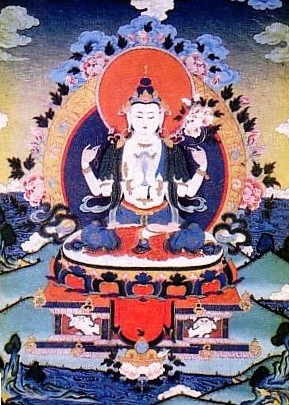Mani Kabum: Difference between revisions
Jump to navigation
Jump to search
(Tibetan.) |
mNo edit summary |
||
| Line 1: | Line 1: | ||
[[Image:Avalokiteshvara.JPG|frame|'''Avalokiteshvara''' courtesy of Lama Tsondru Sangpo]]'''Mani Kabum''' (Tib. མ་ཎི་བཀའ་འབུམ་, Wyl. ''ma Ni bka' 'bum'') - a collection of teachings and practices focused on [[Avalokiteshvara]], attributed to King [[Songtsen Gampo]] and revealed as a [[terma]] by three different masters: the siddha Ngödrup, [[Nyangrel Nyima Özer]], and Shakya Ö. | [[Image:Avalokiteshvara.JPG|frame|'''Avalokiteshvara''' courtesy of Lama Tsondru Sangpo]]'''Mani Kabum''' (Tib. མ་ཎི་བཀའ་འབུམ་, [[Wyl.]] ''ma Ni bka' 'bum'') - a collection of teachings and practices focused on [[Avalokiteshvara]], attributed to King [[Songtsen Gampo]] and revealed as a [[terma]] by three different masters: the siddha Ngödrup, [[Nyangrel Nyima Özer]], and Shakya Ö. | ||
==Further Reading== | ==Further Reading== | ||
Revision as of 00:01, 7 August 2017

Mani Kabum (Tib. མ་ཎི་བཀའ་འབུམ་, Wyl. ma Ni bka' 'bum) - a collection of teachings and practices focused on Avalokiteshvara, attributed to King Songtsen Gampo and revealed as a terma by three different masters: the siddha Ngödrup, Nyangrel Nyima Özer, and Shakya Ö.
Further Reading
- Bryan Phillips, “Consummation and Compassion in Medieval Tibet: The Mani bka’-‘bum chen-mo of Guru Chos-kyi dbang-phyug” (unpublished PhD thesis)
- Matthew Kapstein, 'Remarks on the Maṇi bKa'-'bum and the Cult of Āvalokiteśvara in Tibet', in Tibetan Buddhism: Reason and Revelation edited by Steven D Goodman and Ronald M. Davidson, SUNY, 1992
- Matthew Kapstein, 'The Royal Way of Supreme Compassion', in Religions of Tibet in Practice, edited by Donald S. Lopez Jr., Princeton University Press, 1997